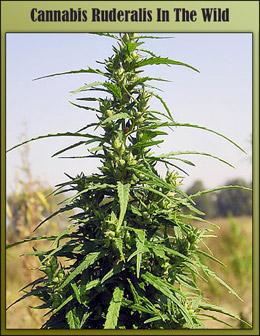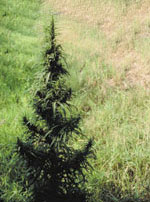
The name 'ruderalis' comes from the German 'ruderal', a term for weeds growing by the roadside or on other fallow land.
Cannabis Ruderalis: Origins
Cannabis ruderalis is an uncultivated strain native to Russia and central Europe and is adapted to the harsher environments found in these locations. Whether seen as a variation on the single cannabis species or as a distinct species in itself, Ruderalis varieties of cannabis are most likely descended from Indica varieties which, in turn, are probably descended from Sativas.
The differences between these three in their growing and reproductive patterns can be linked to the vastly different climates and environments encountered by the original tropical phenotype C. sativa L. as it colonised further and further north of the equator after the last ice age.
Cannabis Ruderalis: Origins
Cannabis ruderalis is an uncultivated strain native to Russia and central Europe and is adapted to the harsher environments found in these locations. Whether seen as a variation on the single cannabis species or as a distinct species in itself, Ruderalis varieties of cannabis are most likely descended from Indica varieties which, in turn, are probably descended from Sativas.
The differences between these three in their growing and reproductive patterns can be linked to the vastly different climates and environments encountered by the original tropical phenotype C. sativa L. as it colonised further and further north of the equator after the last ice age.
Cannabis Ruderalis: Physical Appearance
A typical Cannabis Ruderalis plant is very short in height, often between 10cm and 50cm at full maturity. It displays little or no branching and has wide, fat-bladed leaves, similar to those of an Indica strain of cannabis. Once flowering begins, Ruderalis will gain even less height than an Indica.
Cannabis Ruderalis: Auto-Flowering Ability
The most notable characteristic of the Ruderalis strain is its capacity to flower (and therefore reproduce) according to an individual plant's age, independent of the photoperiod in which it is growing.
Since nearly all flowering plants take their cue to reproduce from the climatic factors indicative of season, the ability to begin this process based on changes in the plant rather than in its environment is known as 'auto-flowering'.
A Cannabis Ruderalis will begin flowering when it achieves a certain stage of maturity - normally after about seven weeks of growth, when it reaches its fifth to seventh internode. Once a Ruderalis has begun flowering, it continues to do so until other environmental factors (most notably winter) cause the plant to die. The other varieties may expire naturally once their reproduction has been accomplished, or may return to vegetative growth if given a long photoperiod.
A typical Cannabis Ruderalis plant is very short in height, often between 10cm and 50cm at full maturity. It displays little or no branching and has wide, fat-bladed leaves, similar to those of an Indica strain of cannabis. Once flowering begins, Ruderalis will gain even less height than an Indica.
Cannabis Ruderalis: Auto-Flowering Ability
The most notable characteristic of the Ruderalis strain is its capacity to flower (and therefore reproduce) according to an individual plant's age, independent of the photoperiod in which it is growing.
Since nearly all flowering plants take their cue to reproduce from the climatic factors indicative of season, the ability to begin this process based on changes in the plant rather than in its environment is known as 'auto-flowering'.
A Cannabis Ruderalis will begin flowering when it achieves a certain stage of maturity - normally after about seven weeks of growth, when it reaches its fifth to seventh internode. Once a Ruderalis has begun flowering, it continues to do so until other environmental factors (most notably winter) cause the plant to die. The other varieties may expire naturally once their reproduction has been accomplished, or may return to vegetative growth if given a long photoperiod.
Cannabis Ruderalis: Growth Cycle
Ruderalis' adaptation to short, cool summers can be seen in other areas. Ruderalis has the ability to complete its life cycle - from being a seed to producing seeds - in just 10 weeks. Its seeds detach easily and can survive more than one season in frozen ground - until conditions are favourable enough to allow growth. The seeds can also survive their shells being cracked open when walked on by humans or animals. For some Ruderalis strains, this occurrence may even aid the germination of seeds.
Cannabis Ruderalis: Properties and Usage
Wild Cannabis Ruderalis strains are nearly always high in CBD and low in THC.
While pure Ruderalis strains have little value in terms of fibre, medicine or psychoactivity, their auto-flowering capability and their extremely fast maturation time are of great interest to cannabis breeders. Hybrids made from combining Indica and Ruderalis strains are currently proving to be some of the earliest-maturing outdoor plants available.
Ruderalis' adaptation to short, cool summers can be seen in other areas. Ruderalis has the ability to complete its life cycle - from being a seed to producing seeds - in just 10 weeks. Its seeds detach easily and can survive more than one season in frozen ground - until conditions are favourable enough to allow growth. The seeds can also survive their shells being cracked open when walked on by humans or animals. For some Ruderalis strains, this occurrence may even aid the germination of seeds.
Cannabis Ruderalis: Properties and Usage
Wild Cannabis Ruderalis strains are nearly always high in CBD and low in THC.
While pure Ruderalis strains have little value in terms of fibre, medicine or psychoactivity, their auto-flowering capability and their extremely fast maturation time are of great interest to cannabis breeders. Hybrids made from combining Indica and Ruderalis strains are currently proving to be some of the earliest-maturing outdoor plants available.





Cannabis Ruderalis